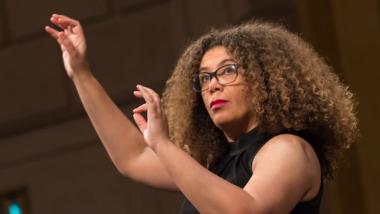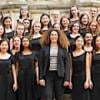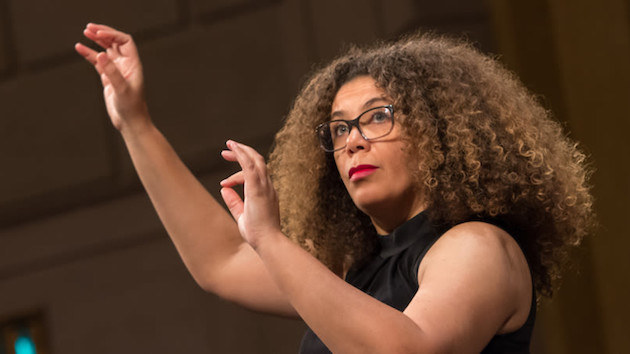
The San Francisco Girls Chorus is recognized as one of the great musical treasures of the San Francisco musical community. Grammy-winning, a valued collaborator with the Symphony, the Opera, and a wide array of other groups near and far across the entire musical spectrum, the chorus has an extensive list of premieres and commissions and has performed at a presidential inauguration and Carnegie Hall. At the helm for the past seven years, the past two as artistic director, five years before that as musical director, is conductor Valérie Sainte-Agathe. Sainte-Agathe completed a long tenure at the Montpellier National Symphony and Opera before coming to San Francisco to help the Girls Chorus to fulfill its mission of “excellence, empowerment, and transformation.”
But how does one lead a choir when studies cite choral singing as the one of the most dangerous things to do in terms of transmitting COVID-19? Amazingly, not only has the group continued the girls’ education online, it has used the constraints to its advantage by bringing in guest artists for master classes and increasing one-on-one instruction. At a time when many of the girls are deeply moved, not to mention upset by recent events, the continuation of study has doubtless been a lifeline.
Talking recently via Zoom, Sainte-Agathe’s screen boasts a backdrop photo of her native Martinique. Blue sky and tall palm trees frame her dramatic mane of hair and sunny smile. A mother of two daughters, Sainte-Agathe and I begin our conversation talking about the social challenges facing young people today.
Directing a choir is such an intensely social job. How has the group been doing with the relative social isolation of the shelter-in-place?
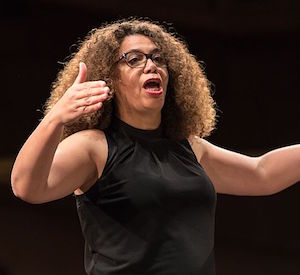
That was my main concern. How to keep the social interaction, the relationship with the singers. We pivoted quickly to online training. I’m lucky, I have a wonderful team. We had spring vacation one week and the next week came back right away. The idea was to keep a sense of normalcy. Keep the same hours, same rehearsal times, and then think about projects. I wanted the girls to still think about working towards something. It was difficult. My ensemble are the older ones, teenagers, young women, and a little bit activists also already, which is great. And they are very opinionated. We had discussions. At the beginning they were so depressed. For some of them school wasn’t really ready so they were not having classes at all, they had to wait, so we wanted to have the organizations be the place where they could come.
We started using Zoom right away and experiencing what we could do with it. Maybe it’s not a bad thing, because after two weeks [of the shelter-in-place], they told me, teenagers told me, we realize we need structure! [Laughs.] Of course what they miss is just being together, being able to sing together. Because I am a performer, I am used to those emergency situations where you just have to fix something right away. I can’t fix this situation but I can make it better. So I started collaborations with guest artists coming to do individual master classes.
We can’t sing together but they can still practice their voice, their training, and have a live class with another teacher. We organized a master class with a voice teacher from the Conservatory, Rhoslyn Jones. So it’s possible to keep working, and we’d better. This is probably going to last. We are singers, if we get together even in small groups we are supposed to wear a mask, and we can’t sing with a mask, we can’t do that. But all the programs in ear training, theory, that works because the one-on-one attention works. The idea is just to keep growing and learning.
We have projects. I called my friends and I said, “You know what, I need to be able to envision what we are working for so it’s not just rehearsal and we learn music.” We are performers. It’s what we do at the Girls Chorus. So I called Kronos Quartet and we created a video with Kronos Quartet that you will see soon. And we had a collaboration with DJ Spooky that’s going to be out in October.
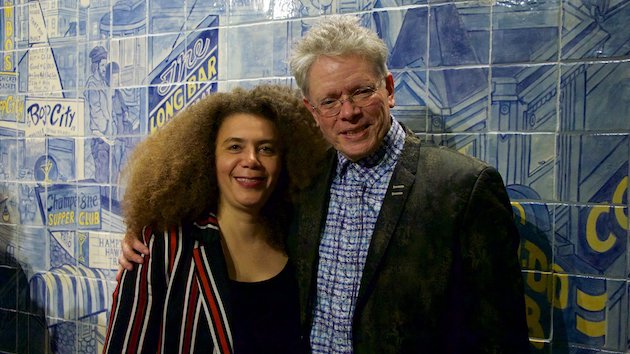
I was worried about seeing the girls in their homes. Sometimes they would start rehearsal in their beds, and it was like, “No way, you guys.” I wanted them to move, so I called a choreographer. Raissa Simpson, who is the artistic director of PUSH Dance Company, has been working with us for two months, twice a week, half an hour, on Zoom. We just decided this is our stage, right here [gestures to the frame of the Zoom picture]. It’s a different stage but it’s the one we have so we use it. She created this beautiful choreography with them using not only from here to the waist, but a lot of movement using the space.
Can you talk about your collaboration with Bayview Opera House and bringing greater diversity to the choir?
The Bayview Opera House is now a campus of the San Francisco Girls Chorus. It’s not an outreach program. It became official this year. We started the collaboration maybe two years ago. I went to see Barbara Ockel who is the director over there and I told her, “I want to have more girls with my hair.” [Laughs.]
The subject is so sensitive. Nobody really wants to talk about it, everybody is afraid to hurt [feelings]. It’s really not because people don’t want to do something, but it’s so sensitive. I think I’m in a place where maybe I can ease the relationship a little bit because first of all I’m not from here, but I’m black, so I can talk about a subject that might be sensitive for everybody. When I went to her, she was surprised that we were reaching out, but right away, we talked about it and she said, “Let’s start something.”
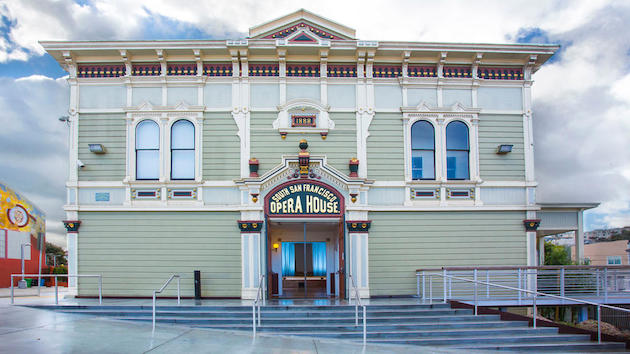
At the Bayview Opera House we opened a prep chorus and Chorus Essentials, just to start the program and make sure we had the singers. Generally, we had 30 singers from Bayview, and this year we’ve decided to also create a Level One and have exactly the same curriculum that we have in San Francisco. We also have a campus in Emeryville. Sometimes I have a hard time with the idea of an “outreach program.” You go, maybe work a little bit, and then you leave. No. This is another antenna of the San Francisco Girls Chorus. We are really clear about that. We didn’t stop the rehearsals (with the shutdown.) We have two directors. Christopher Street and Othello Jefferson. They are both part of our faculty and they are working with girls not only from Bayview, but from downtown San Francisco. They kept working and they had some video projects for the end of the year. The choreographer is included in this project, so we’re still here. Most of the girls stayed through this time. The ones who had the hardest time were 4 or 5 years old and what can you do? You can’t oblige them at 4 or 5 to stay in front of the screen. But otherwise everybody stayed.
What are the different levels of the Girls Chorus?
We have seven levels plus the performance ensemble. We start at 4 years old. We have two years of prep chorus, then we have the training chorus called Chorus Essentials, then we have four levels at the end of which they graduate from the organization. They are assessed according to what they do. It’s not a matter of age. When they are ready, and have their theory evaluations, they can graduate from the school. From there they can audition for my ensemble, the Premier Ensemble. This ensemble is the face of the organization. We do the recordings, the touring, and most of the collaborations with the guest artists. But they have to audition.
During the training they have theory classes, vocal technique, ear training, and they learn the repertoire. We’re going to add a curriculum in improvisation because I think it’s necessary. It’s not something we learn as musicians of classical music so it’s a good thing to start this program. They also have each year a composer-in-residence who comes to them and introduces them to the world of new music because it’s important to me to bring new music and new commissions to the choral field in general.
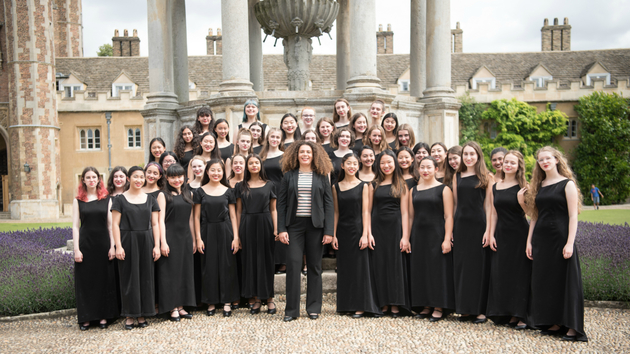
What does it mean to “develop the ear”?
There are two layers. The first would be the technical side of it. If you are singing together and in harmony, just to make sure you are in tune with each other. You listen and you learn how to recognize the chords, how to name the chords and recognize a note in the middle of several notes. And then developing the ear is also, for me, just being aware of what is happening around you. It is not only the music. It’s the empathy you can develop because you are in the social context. You feel also. You hear, but you feel the other and you understand who you are in the middle of a community and to be able to do that you need to listen. It’s not only listening to the notes, you need to listen to what’s going on, you need to adjust; sometimes you will need to support your colleagues a little bit more to make sure that the chord is ringing a little bit more and sometimes not. It’s this constant awareness. For me, you’re not supposed to just learn your part and sing it the same way over and over. That’s why choral music is such a huge lesson for life; in general, we don’t listen enough.
As a singer I always had a hard time when a choir director told me to “blend.” I sort of hate the word blend. I don’t think artists should blend.
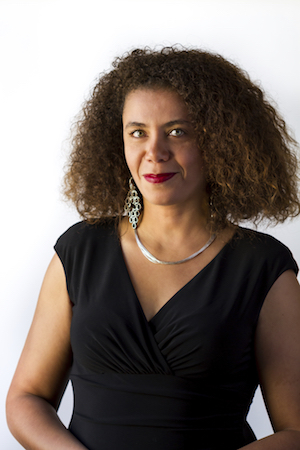
I love that you bring that up because it’s what many people think of chorus and sometimes I hear that, “I like the blending.” Uck. It’s not what I’m doing, actually. I’m coming from the world of the opera. In France, I was working with the opera in Montpellier. The way an opera singer is going to use his voice is different from what people think a choral singer should do, but the way I’m working — and I have a wonderful team in vocal technique, Director of Voice Studies Justin Montigne — and we have the same idea of what we want to hear and how we want to work with the girls.
Each of those girls has a different voice. They have a different color, a different instrument, and I want each of them to use their instrument. It’s not about doing what your neighbor is doing, it’s keeping what you have, your gift, your voice, and seeing how you make that work with the others who are also different people and keep their personalities. There are techniques for that. You work with the vowels, the shape of the vowels, but you keep your instrument, you don’t transform your instrument. That’s very important for me. The sound we get is because of that, because you have the variety of color and this is what I want to have.
We have a program called the Soloist Intensive and each of them have a one-hour class of vocal technique: and this is how we can have those master classes because they are able to sing as soloists and bring that same voice to the chorus. I think it also works because we work with teenagers. This age is the most interesting, because the voice is really interesting, because it’s not a child’s voice, it’s not an adult’s voice; you’re in this in-between when the vibrato is coming and I want to work with that. I know so many children’s choruses just try to stop that [development], and I don’t believe in that. I’m not working like that. It’s a different technique, and it’s a different color. It’s a vibrant color. It’s much more difficult to work on the tuning when you’re doing something like that, but with the work on the vowels and also because they have those classes of ear training, it’s working.
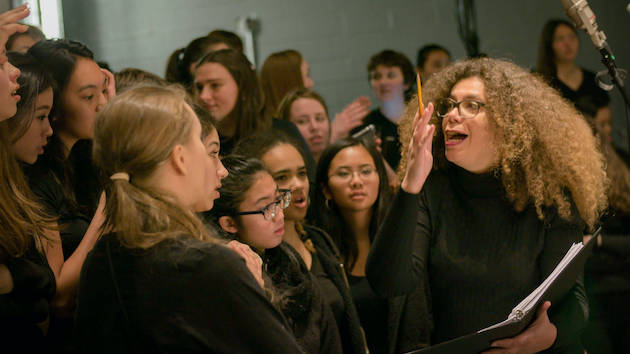
How has the pandemic affected the chorus financially, and in other ways as well?
I was so moved when I saw that the San Francisco Opera was canceling the fall season. It’s something I’m talking to the parents about because of course we are online, we have a different program, and people might think we shouldn’t have the same tuition. But the fact that we are online means I want us to have more individual attention so we need to have more support, more artists, so it’s not less expensive. And we are very proud we have been able to keep our entire staff and we want to keep our entire staff.
The situation is horrible for a lot of people. I’m worried about art in general. It was already difficult for young singers to decide to be artists, decide to be singers, but it’s getting even worse because now I can see that they want to be artists and also do science. I don’t have anything against science, but I’m afraid that if artists are not supported right now it’s going to become difficult [compared to a career in science]. We are in a world where we need artists and we need to make sure that the young generations understand that art is essential. This is something, no matter if you become an artist, if you have access to art in your life you develop empathy and you see the world through a bigger window, so it is important to support the arts and the artists, so we have a lot to do.
Regarding the situation in general, between the quarantine and all the protests for George Floyd, I had conversations with the older singers and they were extremely affected. They were shocked, and that gave me a lot of hope. They don’t understand how this could have happened. As adults, if we are in this situation, we didn’t do a good job; I’m sorry, we just didn’t. And I just hope with the work we are doing we are also bringing those girls to a world where they understand that they can fight, they can make a change. Sometimes you have the younger ones who can’t go to a protest, and I say, “It’s not about going to a protest, it’s also how do you act in your day-to-day life. How respectful are you of other people? How do you listen to everybody? How do you include everybody?” I took the time to talk to my singers who are African American or mixed race. It’s important to make them understand that we are here for them. The organization is here for them.
I’m glad that everybody is beginning to understand that diversity is important. It’s a little bit shocking to me because everybody knows it, but nobody does anything about it. That’s why I’m so proud of this organization. They just hired me, with the way I look, and it was something strong to do in the very conservative choral world in general. It was a strong position to take. They hired me as music director and two years ago they made me artistic director. They gave me the opportunity because they saw the musician. They didn’t stop at my hair or my skin, and they supported the program with the Bayview Opera House, and when I bring in composers from other countries, they support that. That’s the secret, for the future: just do it! Just do it! I know it’s sensitive, but when you’re coming from a place of integrity, it works. You need to work with everybody.
I want to make this a very broad question, please take it any direction you like. Is there anything you would like to say about racism in the U.S.? Or in the U.S. compared to France? What has your experience been as a black artist in the very white field of classical music?
I think my parents protected me a lot, also being from France, we don’t have many discussions about race, probably because of the history of our country where everything is based on citizenship. As a citizen you have rights, you have duties. And that’s it: we are starting from there, so you never see those questions, “Are you black, are you white?” When I arrived here I was really shocked about that. It’s different. We don’t do that in France, but that doesn’t mean we don’t have a problem: you’re seeing protests also in France. I was in the classical music world in France and I think it’s only when I arrived here (in the U.S.) that I actually thought about the fact that I had been the only black. I didn’t notice because nobody made me feel that I had to notice. It’s probably changed now [at Montpellier Opera], but at the time I was the only black. Imagine an entire festival, orchestra, chorus, conductors, and I was the only one.
But I felt it here because there were separations. Communities wanted to protect themselves from each other. At the beginning it was a little bit uncomfortable for me because I’m not part of any one group. I come from the Caribbean. In my family my great-grandmother was from Pondicherry, India, so I have Indian roots, I have African roots, European roots. That’s the Caribbean.
Regarding racism in general, I think everybody is afraid to talk about it. Where choral music is helping is that you bring different people together and you focus on the music. You focus on the sound they want to make and what they want to express. You don’t focus on the color of their skin. But in this country, because there is a need to address the problem, I think it is worth it to talk more about racism with children. How do you help your children not to be racist? It’s about talking about it and not being afraid to ask questions. I think doing that with children is easier than doing it with adults. It’s the right place to do it.

